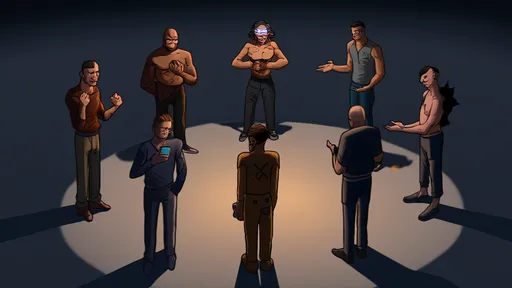It wasn’t until I handed in my resignation that I realized how illusory professional networks can be. For years, I’d meticulously curated my LinkedIn connections and amassed hundreds of WeChat contacts, believing these digital Rolodexes represented real social capital. The sobering truth revealed itself slowly: when the job title disappears, so do 90% of those supposed relationships. What remains isn’t your carefully maintained contact list, but the handful of people who’ll take your call at 2 AM.
The corporate world sells us a dangerous myth – that networking is quantifiable. HR departments encourage employees to attend mixers and exchange business cards as if collecting Pokémon. We’re taught to judge networking success by the number of industry events attended or connections accumulated. This transactional approach creates the professional equivalent of fast-food relationships: convenient, superficially satisfying, and utterly devoid of nutritional value. The moment the mutual benefit disappears, these connections evaporate like morning mist.
Real relationships require friction – those messy, time-consuming interactions that corporate efficiency seeks to eliminate. Consider how we build friendships in childhood: shared struggles over difficult homework assignments, inside jokes from summer camp, the vulnerability of asking for help. Modern professional networking has become the antithesis of this, optimized for maximum efficiency and minimum emotional investment. No wonder these connections can’t survive job transitions.
Social media exacerbates the problem by creating the illusion of intimacy. Scrolling through a colleague’s vacation photos creates a false sense of connection, while birthday reminders trick us into believing we’ve maintained relationships through annual automated greetings. The platforms are designed to make us feel socially fulfilled while actually isolating us from substantive human connection. When you change jobs, these thin connections snap immediately.
The pandemic accelerated this phenomenon dramatically. As professional interactions moved entirely online, relationships became even more transactional. Zoom calls with grids of faces replaced office drop-bys and coffee chats. Networking became about optimizing LinkedIn algorithms rather than building genuine rapport. In this environment, it’s no surprise that post-employment relationships wither – they were never properly rooted to begin with.
What endures? The colleague who covered for you during your mother’s illness. The mentor who gave you brutally honest feedback when you needed it most. The assistant who stayed late to help you meet an impossible deadline. These relationships share common threads: vulnerability, sacrifice, and emotional risk. They were built through shared struggle rather than mutual benefit, which is why they survive role changes.
Traditional networking advice focuses on expanding your circle, but the deeper wisdom lies in contraction. One former executive told me about receiving 300 messages when his promotion was announced – and exactly three calls when he later faced health issues. His story illustrates the Pareto Principle of relationships: 20% of your connections will account for 80% of your real support system. The challenge is identifying which connections fall into that vital minority before you need them.
This isn’t to say weak ties lack value. The “strength of weak ties” theory has merit for information sharing and opportunity discovery. But we’ve confused these useful acquaintances with actual support systems. Your WeChat contacts might help you land an interview, but they won’t sustain you through unemployment. That requires relationships built on something deeper than professional convenience.
The most resilient professional relationships often form in unexpected places. A junior employee who challenged your proposal might become a trusted sounding board. The vendor who refused to cut corners could emerge as a key reference. These connections succeed because they’re based on mutual respect rather than positional authority. When the org chart disappears, these are the bonds that remain.
Some industries understand this intuitively. In creative fields, professionals frequently collaborate across projects and companies. Their networks resemble webs rather than ladders – relationships persist because they’re based on demonstrated competence rather than organizational hierarchy. This model proves more adaptable to career changes than traditional corporate networking.
Technology isn’t the enemy here, but our use of it is. The same platforms that facilitate shallow connections could deepen relationships if used intentionally. Imagine treating LinkedIn like a garden rather than a battleground – cultivating fewer connections more carefully, engaging in substantive discussions rather than perfunctory endorsements. The tools aren’t flawed; our approach to them is.
As I rebuilt my professional life post-resignation, I discovered an unexpected benefit: the clarity that comes from relationship attrition. Losing hundreds of superficial connections created space for a dozen meaningful ones. These surviving relationships shared certain qualities: they involved personal knowledge beyond work roles, they’d survived disagreements, and they didn’t depend on scheduled catch-ups to maintain connection.
The corporate world will continue peddling networking as a numbers game. But true professional resilience comes from relationships that transcend organizational structures. These are the connections worth investing in – not because of what they can do for your career, but because of what they reveal about human connection itself. After all, when the business cards are packed away and the job title fades, these are the ties that actually bind.

By /Jun 17, 2025

By /Jun 17, 2025

By /Jun 17, 2025

By /Jun 17, 2025

By /Jun 17, 2025

By /Jun 17, 2025

By /Jun 17, 2025

By /Jun 17, 2025

By Sophia Lewis/Apr 19, 2025

By Elizabeth Taylor/Apr 19, 2025

By James Moore/Apr 19, 2025

By Rebecca Stewart/Apr 19, 2025

By Ryan Martin/Apr 19, 2025

By James Moore/Apr 19, 2025

By Sarah Davis/Apr 19, 2025

By George Bailey/Apr 19, 2025

By James Moore/Apr 19, 2025

By Amanda Phillips/Apr 19, 2025